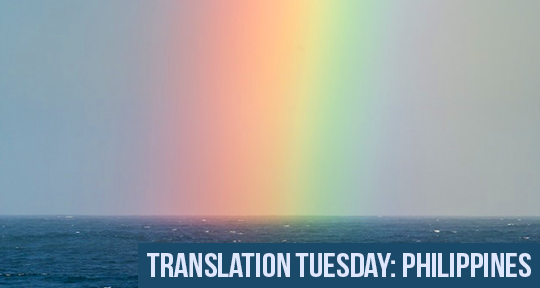This Translation Tuesday, we feature three poems translated from the Hiligaynon – a language that Asymptote is proud to feature for the first time. The poems that addres are from Jhio Jan Navarro’s first chapbook Pinili nga Binaylaybay, Piling Tula (Selected Poems) released by the independent publisher Kasingkasing Press in 2022 that is made up of poems in both Filipino and Hiligaynon. Hear about the process of translating these poems from translator Eric Abalajon.
“Jhio Jan Navarro’s first chapbook tackles themes of intimacy in its many forms and documenting injustices especially in his home province of Negros Occidental. Navarro’s language manages to be both idiomatic and straightforward. What comes out is somewhat familiar to English readers, but now made ironic or imbibed with deeper meaning. In ‘The Bird in The City’, the popular expression ‘the early bird catches the worm’ is revised to illustrate urban cruelty and precarity. While in ‘Figure of Death’, the event of winged termites flocking to a light source during the rainy season might bring to mind the story of the Fall of Icarus. However, probably more recognizable to Filipino readers is its affinity to a story attributed to Jose Rizal, with moths attracted to a lamp instead. The allegory of naive ambition has been transposed to a rural setting, the insects signaling ruin to the household. Lastly, ‘Ortaliz’ tenderly recounts episodes from childhood, but pays careful attention to the landscape of sugar cane plantations and its persistent contradictions. Navarro’s poems are crafted with intricate imagery, and written with urgency and sensitivity to place and its history. I tried to convey this in my translations, where beauty and perseverance are inseparable from death and violence.”
—Eric Abalajon
The Bird in The City
Perches
on branches
bearing red, flickering
light bulbs.
Hums
behind evening’s shade
since streets
are deafening
during the day.
Nests
in many building columns,
rafters, roofs yet
lays no eggs.
The bird in the city
flies straight into traps
and the one that remains
after others have gone
catches the most worms.
Figure of Death
Do not put out the oil lamp,
the candle. Do not turn out the lights
if they enter
from the cracks of the earth
to shelter from the rain
Shortly their wings will
wither like dried
bamboo leaves
and their dying bodies shall
fall writhing on the floor.
For a moment,
let them as they take part
of the heat, the gleam, the brightness.
The day will come when
you shall be as them
close to being blown over,
holding on to any
likeness of heaven.
Ortaliz
We grew up only with the remaining walls
yet if the thick grass that shrouds
and the moss that covers the
surviving foundations, floors, and broken
staircase would be cleared, it is not hard
to imagine what stood here before
looked very much like the Ojeda mansion
seen in Oro, Plata, Mata.
For certain, elderly peasants and carabao herders
hold countless memories about the
sugar barons who use to reside here.
The way they sipped sweet coffee in the terrace,
the spacious and wide rooms,
and the songs accompanying
passersby as they head home.
Since we only know the remaining walls,
we picked to sit near the broken staircase
under the shade of the kamonsel and bugnay trees,
as we chew off fresh sugarcane and tell overblown stories.
The maria capra welcomes us with a song
as we enter the metal gate
and the chorus of cicadas and crickets
later lead us home.
These are our memories of the ruins.
Translated from the Hiligaynon by Eric Abalajon
Jhio Jan Navarro was born and raised amid the sugarcane fields of Brgy. Don Jorge L. Araneta, Bago City, Negros Occidental. He writes poetry in English, Filipino and his mother-tongue, Hiligaynon. His works have appeared in Cha: An Asian Literary Journal, TLDTD, Modern Poetry in Translation, and elsewhere.
Eric Abalajon is currently a lecturer at the UP Visayas, Iloilo. His works have appeared in Cha: An Asian Literary Journal, The Tiger Moth Review, Modern Poetry in Translation and elsewhere. Recently his poems are included in the collections Sobbing in Seafood City (Sampaguita Press, 2022) and Footprints: An Anthology of New Ecopoetry (Broken Sleep Books, 2022).
*****
Read more from Translation Tuesdays on the Asymptote blog:

